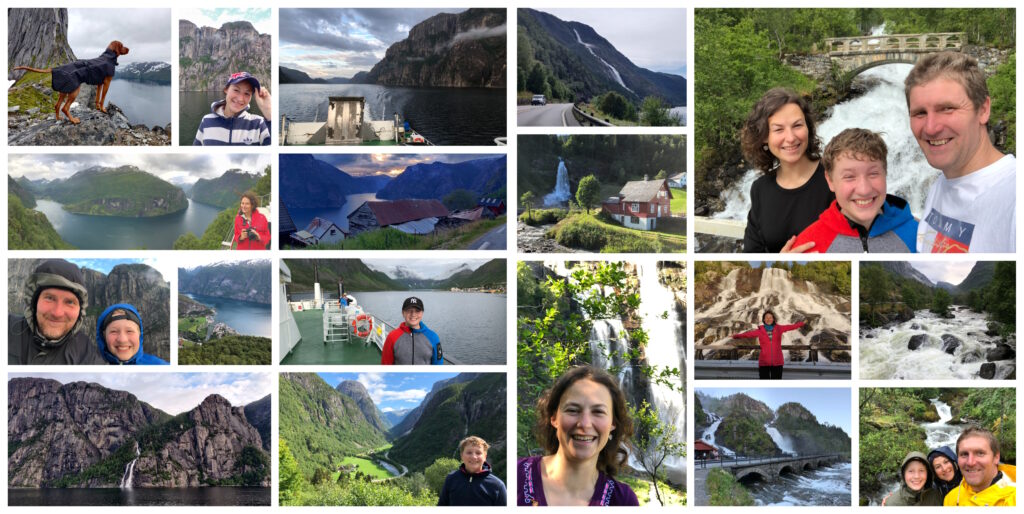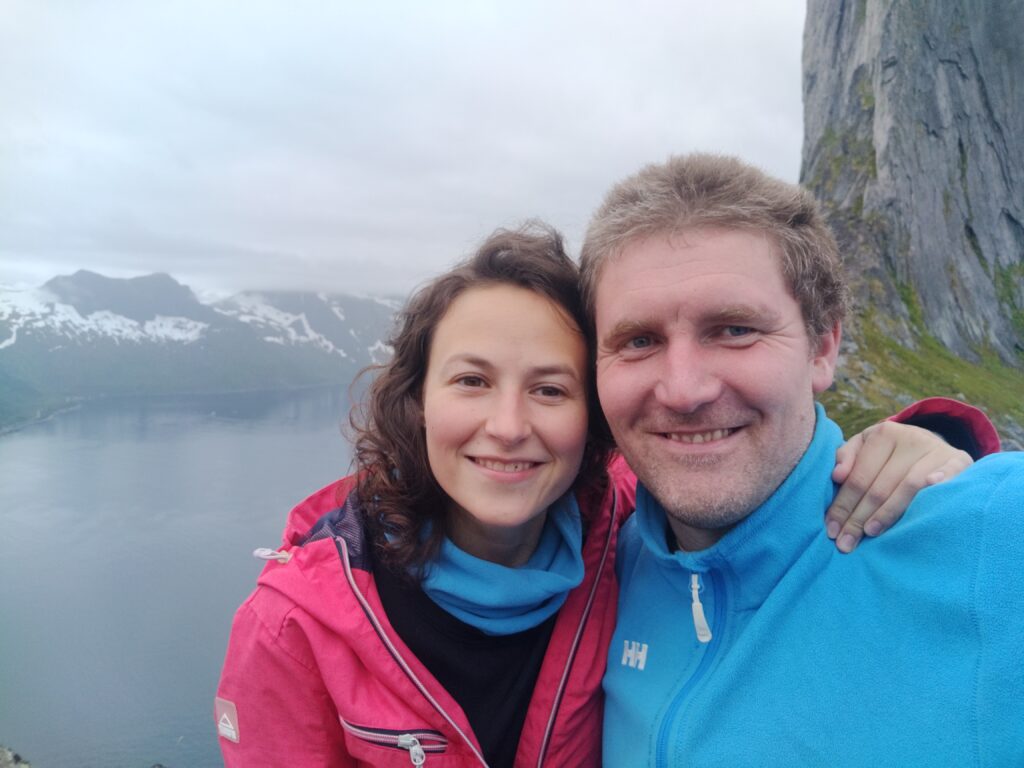We had 26 days to cover what would turn out to be 6715 km by road and another 563 km by ferries of the most stunning scenery in Europe. Wife Tania, son William, and our trusty dog Jimmy were signed up for the camping road trip out of the back of our Skoda station wagon. It was a tight fit with the dog and the camping gear but we managed get it all in.
We slipped out of Finland in July of 2020 just as COVID was heating up. Both Finland and Norway had closed their borders to Sweden but the border between Finland and Norway was still open. The plan was to come back via Sweden and do our quarantine from home in Finland.
The Route
The plan was to head up along the west coast of Finland after visiting our friends in Hanko. We would take the Karigasniemi border crossing out of Finland and head up to Nordkapp, Europe’s most northern point.
From Nordkapp we would drive across to Tromsø, and out onto the archipelago, island hopping our way down to the Lofoten peninsula. This would turn out to be the most scenic driving of the trip.
After taking the ferry off the Lofoten peninsula to Bodø, we would move quickly 913 km south to the scenic Atlantic Ocean Road before hitting up the incredible fjords of western Norway.
From our last western fjord at Lysebotn, we would work our way home via Oslo and Stockholm, taking the ferry back to Turku and driving the last 169 km to our home in Espoo. Our only mishap of the adventure ended up being on that last stretch from Turku. We hit a fox but fortunately made it straight to heaven and insurance covered the damage.
The Hikes we chose
The toughest hike we did was Trolltunga. It was 27 km round trip walk with about 800 m of assent. The second most difficult was Knivskjelodden track up in Nordkapp which was only 17.2 km return. Both were gorgeous tracks.
We had put a fair bit of effort into readying our 12 year old son William both mentally and physically and he did surprisingly well. We and the dog were fine as 5 – 10 km a day is our normal routine.
On the Lysebotn fjord we did Preikestolen which was comparatively easy but the weather was bad so we didn’t get a good view. We wanted also to do Kjerag but ran out of time.
A couple of shorter hikes we loved were Mannen Haukland, Måtind and Hesten which were all close to the Lofoten Peninsula.
Jimmy the dog had no fear of heights and made us all nervous to be around him.
We used the websites Visitnorway.com, Alltrails.com and the app Outtt to find information on hikes. Ut.no which is owned by the Norwegian trekking association is also a good resource.
Side note: I would have loved to do the via ferrata climb in Loen with the family that I did on my own a few years back. Not surprisingly I didn’t get any takers but I totally recommend it to the brave.
Our Favorite Fjords and Waterfalls
It’s hard to drive 10 minutes in Norway without passing a waterfall or two. During the spring and summer a lot of water needs to make its way down from the mountains. The biggest and most powerful waterfalls are in the west of Norway.

Our two favorite were the twin Låtefossen waterfall near Odda (bottom second from right) and the Steinsdalsfossen waterfall which you can walk under (picture with red farm house).
Tania starred all the waterfalls on Google maps beforehand and made sure we didn’t miss any.
Our favorite fjords were Geiranger, Nærøyfjord and Lysefjord. They are all within a 350 km radius of Oslo. The best to experience them is by car ferry.
I particularly enjoyed the drive from Lysefjord towards Oslo. It was a windy road with pretty lakes and rock formations. The road is called Suleskardveien. (pictured right)
Other Nice Memories
The best part of the trip was introducing my family to Norway. My son bonded with the place and I wouldn’t be surprised if he moves there when he is older.
William also got a taste of Finnish Lapland as we made our way up to Norway. He saw Reindeer and even got to visit Santa in Rovaniemi. I especially enjoyed Inari in Lapland as it is such a peaceful place.
Tania and I had quality time walking on the white beaches in Lofoten and skinny dipping in the freezing mountain river which we might have been reluctant to do without the sauna.
Hiking up to the Briksdal glacier was also spectacular (cover photo). Sadly it has been melting away over the last century.
We also enjoyed visiting the Atlantic Road as it is interesting from an engineering perspective. The down side is the place gets a lot of visitors and the carpark is full of geriatric motorhome drivers that aren’t comfortable driving their massive rigs.
Our Accommodation
We were camping most of the time to save money and also get access to the nicest nature. Our favorite camp site was Uttakleiv Beach pictured to the right.
The biggest challenge we had was bad weather. It took a fair amount of effort to dry everything out after rain.
To make our life easier we picked up a big tarp that covered both of the tents and kept the rain off. It also blocked out some of the light making it easier to sleep at night as the sun did not set in the north.
We experimented with different configurations with the tents and tarp, driven by what we were optimizing for. Sometimes to keep out wind and rain and other times to make our two tents appear to be one tent when there was a per tent fee.
We slept on air mattresses in the tent to get us up off the cold ground and used reflective foil mats on top of the mattress to keep our body heat in. We also carried a bunch of blankets and sleeping bags. We kept all the bedding in a big pillow case which made it easy to manage.
The tents stayed dry inside even on our wettest days. Setting up camp took about an hour per day and breaking camp took a little less, especially if it hadn’t rained. Drying out gear was painful at times especially our rubber jackets and pants. We have since all upgraded to Gore-Tex which is definitely worth the investment for longer and more strenuous hikes.
On the trip we stayed in a cabin or a hostel every now and again if we could find one within our budget. Even though some of the cabins were very basic it gave us a welcome break from the elements and setting up the tent.
The Menu
We saved money in other things but we ate well. The family endured my cooking during the trip with only occasional relief by means of a hot dog or pizza. Restaurants were a bit out of our budget. Tania was our salad master and managed to make delicious arrangement from whatever happened to be on hand.
We carried a day or two of food in our ice box which also doubled up as our kitchen table. Cooking was done on a gas stove. One bottle of gas would last a few days. We carried spices and other condiments to make the food more interesting.
We ate surprisingly well every day ; lamb cutlet, prawns, salmon and occasional Pork ribs cooked on a disposable BBQ. We carried about 20 liters of water which would last us a couple of days. If we needed more there was usually a stream or waterfall close by.
On hikes we took lots of dried fruit and muesli bars for energy. Tania kept the chocolate hidden only bringing it out when all the healthy stuff had been consumed.
Travelling with our dog
The Nordics are pet friendly so it is easy to travel with a dog. Jimmy enjoyed all the hiking and car travel but he wasn’t a big fan of the camping; flapping tents and strange noises kept him awake at times. Jimmy did though enjoy sharing the tent with William and they kept each other warm on cold nights.
All of the camp sites we found allowed dogs but required them to be on leads. We followed this when walking around the grounds but was less necessary around the tent as our boy Jimmy has been trained to stay close. We easily also found cabins that allowed dogs as long as they stay off the beds.
In Norway dogs are allowed on all of the hikes. Jimmy was fine in the cold as long as we kept moving. He wore a rain jacket on the wet days and a woolen jumper around the camp. There are Ticks in Norway but we did not have any issues. Jimmy wears the Tick collar anyway which keeps them away. We travelled early in the season so Mosquitos weren’t much of a problem either.
Our Budget
The final spend came out at €3544.92. I knew Norway was going to be expensive but hoped camping and cooking for ourselves might keep costs down. We ended up spending €137 a day which was a bit higher than the €100 I had hoped for but was still within reason.
Lodging came out on average at €20 a day which was good. Occasionally we had grabbed a cabin and other times free camped. Towards the end, especially in southern Norway we had opted for paid camp sites for the convenience and hot showers.
Transport came out at €38 a day, much better than I expected given all the ferry crossings. The average distance of 280 km a day seems high but in practice we were having slow days when it was scenic and faster days when there was less to see. Plus there were some ferries in those numbers.
Food was the big surprise demolishing 49% of the budget. In hindsight though we did eat well and probably could have spent less if we needed to. Our average food spend was €67 a day which mostly consisted of groceries. Eating out was usually hotdogs and drinks at a gas station or pizza which could easily cost €50. We only ate out at proper restaurants 3 times on the trip contributing a modest €177 to the total.
Entertainment averaged out to €10 a day. On the list were Park entry fees, Cable cars, Sauna, Museums and Churches. The more exotic ones were a visit with Santa in Lapland and an Aquarium. Miscellaneous was just our laundry bill we accumulated along the way.
Conclusion
 Andy and Tania
Andy and Tania
This was my 3rd road trip in Norway with the previous two being by motorbike. You can’t get bored with Norway, there is always so much to see and do.
Lofoten was our favorite part of Norway even though it was annoyingly cold. Nærøyfjord World Heritage Area comfortably gets second place. Third place would go to Lyseford if you want to hike or Geiranger if you just want to sit on a boat.
If you are travelling with kids, they need to be old enough to handle a lot of driving and walking. Make sure you have proper gear for the hikes because the weather can get nasty.
Norway is expensive and you need to plan for that. You can’t expect to find last minute affordable accommodation so either book in advance or take a tent. The north is a lot more expensive than the more southern parts.
I hope this info is useful to anyone planning a trip to Norway. You can also check out my other article on Tips for travelling Norway. Safe Travels!